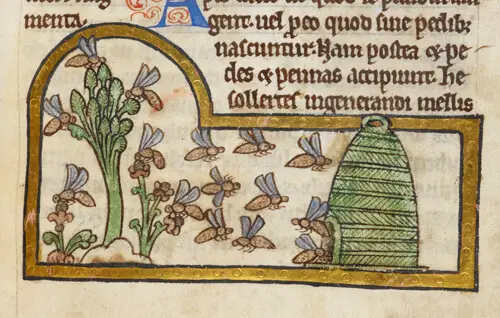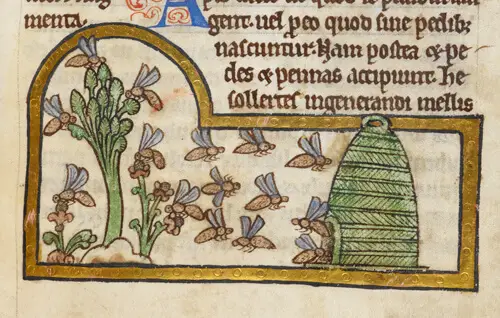Ah, the medieval times! A period when spells and charms were the go-to solutions for life’s little problems. Among these were “metrical charms,” a blend of herbal medicine, prayer, and ritual. These charms tackled everything from barren lands to lost cattle. But let’s zoom in on one that’s particularly buzzing: “For a Swarm of Bees.”
The Ancient Art of Bee Whispering
Dating back to the 9th century, “For a Swarm of Bees” is a swarm charm. What’s that, you ask? It’s a magical spell used by beekeepers to keep their honeybees from flying away when they swarm. The charm starts with a physical action—throwing earth under your right foot—and ends with a poetic incantation to the bees.
The Incantation
- Throw Earth: “Take some earth, throw it with your right hand under your right foot.”
- Speak: “I catch it under foot, I have found it. Lo! Earth has power against all and every being.”
- Dust the Bees: “Throw dust over the bees when they swarm.”
- Speak Again: “Sit you, victory-women, settle to earth!”
The term “victory-women” refers to the bees as powerful females, akin to Valkyries. Other swarm charms used pet names like “little animals” or “dear ones.”
The Evolution of Beekeeping
Swarm charms were in vogue until the 19th century. Why? Because beekeeping evolved! The Scientific Revolution brought new technology and a shift from magical thinking to scientific understanding.
Key Changes in Beekeeping:
| Era | Method | Hive Type | Outcome |
|---|---|---|---|
| Medieval | Swarm Charms | Skeps | Harvest by destroying hive |
| 19th Century | Rational | Wooden | Harvest without harm |
The Superorganism and Its Dance
Today, we understand bees as a superorganism. Gene Kritsky, an expert on beekeeping history, explains that swarming is a way for this superorganism to reproduce. When a hive gets crowded, the queen leaves with two-thirds of the bees, and a new queen takes over the original colony.
Modern Beekeeping Practices
- Watch for signs of swarming
- Provide ample space for colonies
- Use empty hives for new swarms
The Skep and The Wooden Hive
Medieval beekeepers used skeps, woven straw or wicker hives. These were hard to inspect and required destroying the hive for harvest. Come the 1850s, wooden hives with removable frames changed the game. Honey could be harvested without harming the bees.
The Church and The Bees
Interestingly, many swarm charms were composed by medieval monks and nuns. Beeswax was pure and noble, ideal for church candles. Plus, bees symbolised an orderly Church hierarchy. Even the tithe could be paid in skeps!
Swarm Charms Over Time:
- Before the 17th Century: 96% included Christian references
- 18th to 20th Century: 58% included Christian references
The End of an Era
By the mid-19th century, swarm charms were out, and “rational beekeeping” was in. Techniques like “driving the bees” and using glass jars for honey storage became popular. As Kritsky puts it, “Beekeepers have been pretty ingenious over the years.”
So, are magic words necessary anymore? Probably not. As Kritsky muses, “the bees aren’t listening.”
Swarm Charms: The Cultural Significance and Controversy of Insect Repellent Traditions
Swarm charms have been used for centuries as a way to protect people and animals from the dangers of swarms of insects or other pests. These charms are often made from natural materials like herbs, animal parts, or even human hair. They are believed to work by either repelling the insects or by attracting them away from the person or animal wearing the charm.
In some cultures, swarm charms are still used today. For example, in parts of Africa, people wear bracelets made from elephant hair to protect themselves from tsetse flies. In other parts of the world, people use garlic or other herbs to repel mosquitoes.
While there is no scientific evidence to support the effectiveness of swarm charms, they continue to be used by many people around the world. Whether they work or not, they provide a sense of comfort and protection to those who wear them.
Swarm Charms
Swarm charms are often associated with traditional beliefs and superstitions. In some cultures, they are believed to have magical powers that can ward off evil spirits or bring good luck. For example, in ancient Egypt, people used amulets made from scarab beetles to protect themselves from scorpions and other dangerous insects.
Swarm charms are also popular among beekeepers, who use them to protect their hives from pests and predators. Some beekeepers believe that certain scents, such as lemon grass or spearmint, can attract bees and help them find their way back to the hive.
Animal Rights
Despite their popularity, swarm charms are not without controversy. Some animal rights activists have raised concerns about the use of animal parts in these charms, particularly those made from endangered species. Others argue that relying on swarm charms can create a false sense of security and discourage people from taking more effective measures to protect themselves from insect bites and stings.
Whether or not swarm charms work is largely a matter of personal belief. For those who swear by them, these charms are a powerful tool for protecting themselves and their loved ones from the dangers of swarms. For others, they are little more than a quaint relic of a bygone era, with little practical value in the modern world.
Lack of Scientific Evidence
Despite the lack of scientific evidence, swarm charms have a rich cultural and historical significance. They offer a glimpse into the beliefs and practices of different societies throughout history, and the ways in which people have sought to protect themselves from the dangers of the natural world.
Moreover, swarm charms can serve as a reminder of the importance of respecting and preserving the natural environment. Many of these charms rely on natural materials and traditional knowledge of the natural world. By using these resources responsibly, we can help to ensure their continued availability for future generations.
In the end, whether or not one chooses to use swarm charms is a personal decision. However, it is important to remember that there are many effective ways to protect oneself from insect bites and stings, including using insect repellent, wearing protective clothing, and avoiding areas where insects are known to congregate. By taking these precautions, we can enjoy the outdoors without fear of swarms and other pests.
Helpful Links
Here are some helpful links related to swarm charms and insect repellent:
- Natural Insect Repellents: Alternatives to DEET – an article that provides information on natural alternatives to chemical insect repellents.
- The History and Science of Bug Repellents – an informative article that explores the history and science of insect repellents.
- Swarm Charms: A Cultural Perspective – a scholarly article that examines the cultural significance of swarm charms in different societies.
- Insect Repellent Clothing: Does it Really Work? – an article that discusses the effectiveness of clothing treated with insect repellent.
- Mosquito-Proof Your Yard With These Best Mosquito Sprays – a list of some of the best mosquito sprays available on the market.
This image is part of an ancient manuscript from the 1st quarter of the 13th century.





